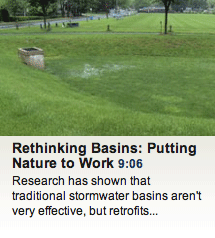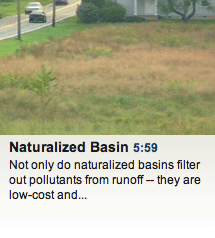
The thousands of traditional stormwater detention basins that were intended to manage runoff have exacerbated problems over the years. Retrofits can greatly improve water quality and the health of our rivers and streams.
Basin Retrofit
Over the years, the vast majority of "stormwater detention basins" were designed with flood prevention in mind. Their purpose was to collect runoff from roads, buildings, and parking lots and channel it away from the site and into a nearby stream as quickly as possible. In doing their job, they created erosion and water quality problems downstream.
The current thinking about basins calls for slowing the flow of runoff, spreading it out, and enabling natural processes like evapotranspiration and infiltration to return it to the atmosphere or soak it into the ground. The result: better water quality and healthier streams.
Videos
Check out these video case studies for a look at the naturalizing process and how existing basins are being retrofitted to make them act in a more effective and holistic way:
Related News from our Blog
Wednesday 01, February 2012
A recent article in the Center for Watershed Protection's newsletter on the costs and benefits of green infrastructure raises some interesting points. ...
Read Full Post >> >>
Research, Green Infrastructure
Comments: (1)
Compare and Contrast
Our partners at the Pennsylvania Environmental Council, in cooperation with a regional basin retrofit advisory team,
have developed a series of simple, low-cost retrofit measures that can be employed to help protect our waterways and control pollution.
This interactive looks at the problems associated with "traditional" stormwater detention basins, and offers a variety of ways retrofits can Slow, Spread, and Soak the water from runoff.




